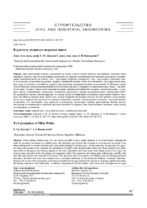К расчету угловых сварных швов

Date
2020Publisher
Another Title
To Calculation of Fillet Welds
Bibliographic entry
Давыдов, Е. Ю. К расчету угловых сварных швов = To Calculation of Fillet Welds / Е. Ю. Давыдов, А. И. Бондарович // Наука и техника. – 2020. – № 5. – С. 367-371.
Abstract
При выполнении сварных соединений не всегда удается плотно прижать соединяемые элементы перед наплавкой сварного шва. В нормативных документах по сварным соединениям допускаемый зазор между соединяемыми элементами может достигать: 3 мм – при сварке покрытым электродом; 2 мм – при сварке в защитных газах. В то же время в нормативах по расчету сварных соединений наличие зазора не учитывается. Для определения влияния зазора на несущую способность сварного шва проведены экспериментальные исследования. На Минском заводе технологических металлоконструкций были изготовлены образцы со сварными соединениями двух типов – для работы на сдвиг и отрыв. С целью сопоставления половину образцов изготовили без зазоров, а другую половину – с зазорами между соединяемыми элементами. Испытания проводили в научно-исследовательской лаборатории БНТУ. По результатам опытов сделаны выводы, что зазоры между соединяемыми элементами существенно снижают несущую способность сварных швов. Кроме того, осмотр поверхностей разрыва показал, что при наличии зазора поверхности среза сварного шва проходят по границе сплавления основного и наплавленного металлов. Экспериментально установлено, что имеющийся зазор приводит к некоторому увеличению глубины проплавления. Однако последний фактор не компенсирует снижение несущей способности сварного шва, обусловленное наличием зазора между соединяемыми элементами.
Abstract in another language
When making welded joints, it is not always possible to press tightly elements to be joined before surfacing the weld. In normative documents on welded joints, the allowable gap between the elements to be connected can reach 3 mm when welding with a covered electrode and 2 mm when welding in shielded gases. At the same time the presence of a gap is not taken into account in the standards for calculation of welded joints. Experimental studies have been carried out to determine effect of the gap on the bearing capacity of the weld. Specimens have been made with welded joints of two types: for work in shear and pull-out. For the purpose of comparison, half of the specimens have been made without gaps, and the other half with gaps between the elements to be joined. The specimens have been made at the Minsk plant of technological metal structures, and their tests have been carried out in a research laboratory of the Belarusian National Technical University. Based on the results of the experiments, it has been concluded that the gaps between the elements to be joined significantly reduce the bearing capacity of the welded joints. In addition, inspection of fracture surfaces have shown that, in the presence of a gap, the cut surfaces of the weld pass along the fusion boundary of the base and deposited metals. It has been experimenttally established that the existing gap leads to a slight increase in the penetration depth. However, the latter factor does not compensate for the decrease in the bearing capacity of the welded joint due to the presence of a gap between the elements to be joined.
View/
Collections
- № 5[12]
